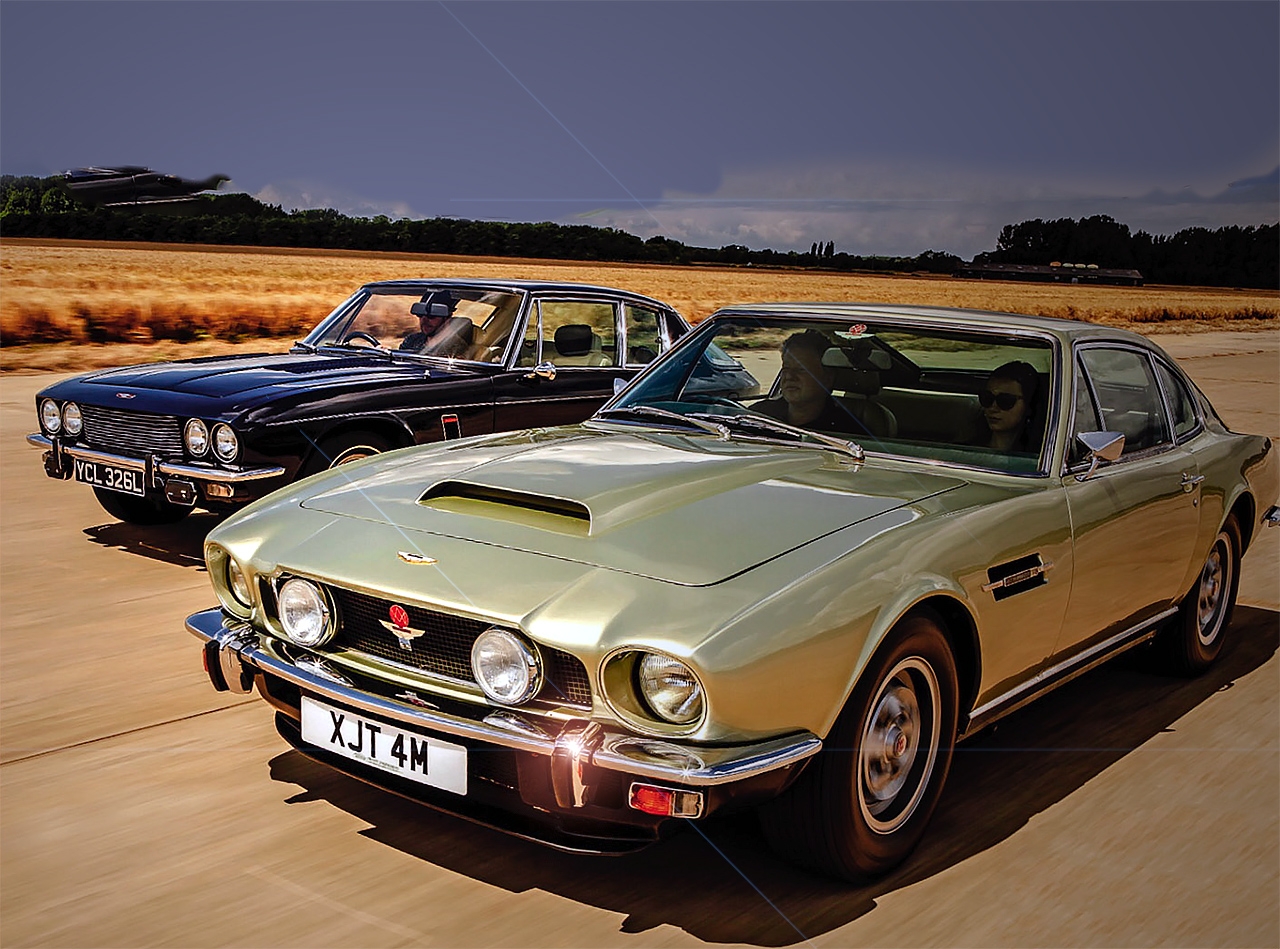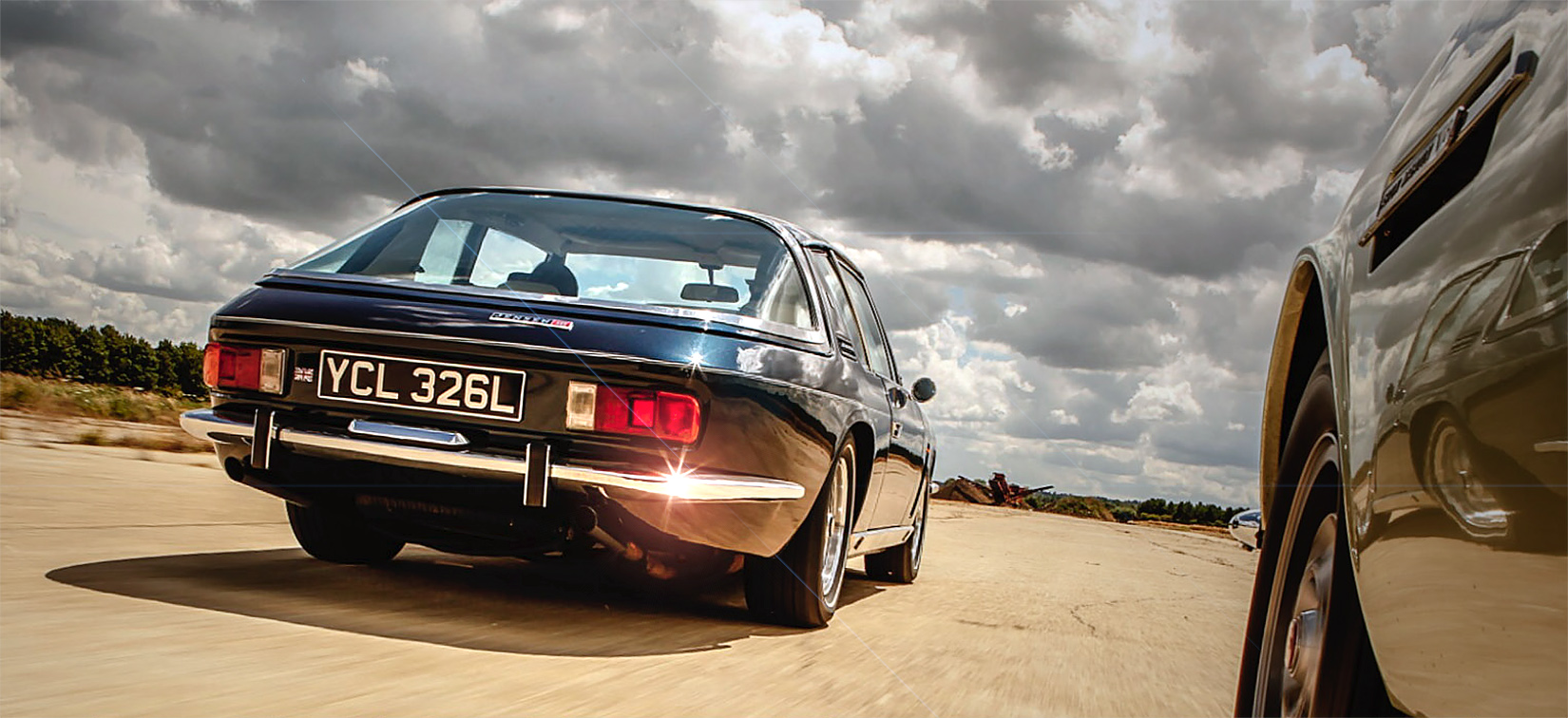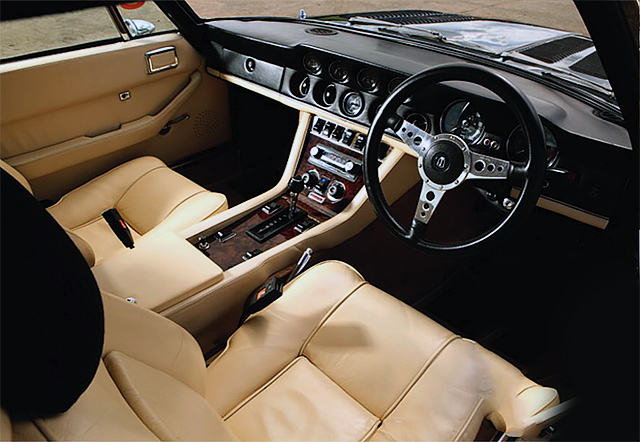
Battle of Britain Aston Martin V8 vs Jensen Interceptor III. One of these beautifully hand-finished grand tourers is worth twice as much but, asks Martin Buckley, is the Aston V8 a better car than the Jensen Interceptor? Photography Tony Baker.
Because history and the passage of time have a way of skewing our perspectives on cars and their places in time and culture, I would understand if you didn’t think the Aston V8 and Jensen Interceptor were really the same sort of thing. Rewind 40-plus year s and your perceptions – unsullied by today’s rampant price hyping-would be quite different. These were Britain’s most accomplished contributions to the world of Gran Turismo motoring in the late 1960s and early ’70s. Close-coupled coupes of handsome aspect, plus serious weight and substance, exquisitely tailored in traditional materials and built for a non-price-sensitive elite who were not quite ready for a Silver Shadow but wanted to go as quickly as possible as comfortably as possible.

Both vehicles had a certain adult boardroom appeal that chimed with the wealthy middle-aged market they were chasing; cars not so much for GT men as G&T men. In terms of size, weight and common purpose, it would be hard not to have pictured them as head-on rivals for the same customers.
Not so today. The Jensen, by reputation, is louche and ephemeral; a raffish dinosaur of the pre-fuel crisis hedonism era powered by a massive American V8 that will take it past everything but a petrol station. Its reputation is in the ascendancy today, but perhaps by virtue of sheer numbers built – it was the most successful of all the Euro-American GTs – its image slightly lacks the polish that the basic excellence of the product deserves. To own an Interceptor in 2014 is still ever so slightly pub landlord.
The Aston, in contrast, has become a national treasure, pure in thought and deed. Hand- beaten, hand-stitched and seemingly only driven by hand-picked gentlefolk who can afford to give it the attention it deserves.
A glance under die bonnets of the cars tells the story succinctly: the Interceptor’s Chrysler V8 is an anonymous if businesslike piece of ironmongery that cannot begin to compete with the handsome alloy cam boxes that make the Aston’s engine bay a visual treat even for those who might not understand what they are looking at.
Satisfied Jensen customers bought into the international jetset flavour of the Italian-styled, American-engined and British-built Interceptor. In many ways, though, the car’s greatest strength – that vast, smooth, reliable and cheap-to-repair Chrysler motor – has proven to be its greatest weakness in the eves of its detractors.
Not that it had many critics in its heyday, although you can imagine that a price discrepancy of up to £2000 in favour of the Jensen by 1974 might have caused irritated Aston salesman to stick their noses in the air and dismiss the “common” Interceptor as a mere trinket that was not even in the same league. In truth, anyone who could afford to pay £7000 for a car in the early ’70s probably didn’t let the odd two grand sway their decision either way.

From far left: broader Aston cabin has a slightly sportier dash, with Smiths instruments grouped in crackle-black surround. V8 corners flatter, with sharper steering; glorious hand-built quad-cam V8; famous names adorn vents; similar 15in alloys, but Aston’s 7in rims (on left) are half an inch wider.
If the Aston had a certain snob appeal – based around price, rarity and a fading racing pedigree – then let’s not forget that the Jensen was an expertly promoted fashion item. Aston Martin may have had the movie allegiance of a fictional superspy, but Jensen Motors of West Bromwich never lost an opportunity to let the world know it had sold yet another Interceptor to an actor or pop star. The likes of Harold Robbins, Mike and Bernie Winters and Eric Morecambe (who had his first heart attack at the wheel of his Interceptor) gave the Jensen a very showbiz profile.
Both cars traded on their ‘handbuilt in Britain’ image. Each Aston Martin V8 was famously the responsibility of one man in a very self-contained factory where all of the machining was done in-house and no more than seven cars were produced per week. Jensen boasted that each Interceptor – constructed around a chassis of two 4in, 9 1/2ft-long steel tubes with floors and bulkheads arc-welded to them, took 10 weeks to build. And it wasn’t signed off until – after a 120-mile road test – one of the board of directors had driven it home and given it the ‘okay’.

The departure of Sir David Brown as boss meant a change of name for the Aston in 1972 (it became simply the V8 rather than the DBS V8) and coincided with the wise decision to replace the Bosch mechanical fuel injection with four Webers, maintaining performance yet improving low-speed drivability and even economy (from 12 to 15mpg). William Towns had already remodelled his original ’67 shape-with a simplified grille and two 7in headlamps – but the rest of the unstressed alloy panels remained unchanged, supported by a nigged steel platform of welded pressings and strategically placed box sections.
Tadek Marek’s 5.3-litre quad-cam V8, sand-cast in LM8 alloy, was only 30lb heavier than the straight-six it supplemented (and later replaced entirely) and a far better match to the Chrysler Torque-flite three-speed automatic gearbox that was looking as if it might become the rule rather than the exception when buyers specified their cars. Previous generations of self-shifting Aston Martins had been leisurely, cumbersome cars but this latest carburetted V8 was so powerful, and the automatic transmission so smooth and responsive, that it made the notchy (if strong) ZF five-speed manual box seem like hard work.

From top: signature rear screen; Chrysler V8 is well back in chassis, giving nicely balanced handling; Havishly appointed cabin, but safety regs dictated that dash lost Si’s bank of toggle switches and gained padded surfaces.
Producing a fast, credible automatic GT Aston was a reaction to the conspicuous success of the Interceptor. Since the days of the glassfibre-bodied C-V8, Jensen had been establishing the idea that an auto could be satisfying and – other than a handful of early examples – there were no manual Interceptors. By the time the Interceptor III arrived in 1971 – the first model built under Kjell Qvale’s leadership – the very idea of a do-it-yourself version would have seemed absurd. With new GKN Kent alloy wheels, the five-year-old design (by louring of Milan) had successfully refreshed itself for the new decade and, for the following year, was due to get the latest 7.2-litre 440cu in V8, which was quieter and had even greater torque but no more power.
I know these two like old friends, but I’ve never had the chance to hop from the driving seat of one to the other on the same day hi the case of either car, I have a preference for the ‘pure’ first editions; I like my Interceptors on RoStyles and my Astons with four lights rather than two.
Aesthetically, I have an overall inclination towards the Jensen, a finer-boned car than the Towns-designed Aston, which seemed to run to flab quickly with each successive attempt to update it. A more neatly detailed and expertly resolved shape than the Aston Martin V8, the Jensen Interceptor maintained its lithe profile and its strong jaw-line to the end.

From top: squat Aston Martin also has a decent boot; huge vent helps with engine cooling; likewise the Jensen’s louvred SP bonnet; neither is a full four-seater but Aston just has the edge; Interceptor leans more but handles well, though bumps can upset it; limited legroom but it’s comfy in the back.
Which isn’t to say that the Aston is not a handsome vehicle with some powerful contours that emphasise the dozens of hours of handiwork in its aluminium panels. It’s just that there are some clumsy bits that spoil it, such as the black fairings under the bumpers at either end hiding ugly exhaust or suspension components.
More light – from the trademark goldfish- bowl rear window – and lower door window sills make the Jensen marginally the nicer place to sit. Its dashboard is more ordered and highly styled than the Aston’s workmanlike display of chrome- rimmed gauges, where you feel as if you are peering over the looming dash and the massive bonnet bulge. The levels of detail fit and finish are of a similarly high order in both cars, with various jaguar and generic Leyland switches and furniture evident but well integrated. In an opulent landscape of hand-stitched leather and chrome, their humble origins aren’t that obvious.
Both cars are packaging disasters, with biggish boots and marginal rear seats. Neither is a real four-seater but, as luxurious 2+2s, they must make admirable long-distance cars even now. There’s not a lot between them in terms of reasonably low wind noise at high cruising speeds, excellent straight-line stability and the potential to romp along at 100 or even 120mph without evidently expending much effort.
In terms of handling, the Jensen makes you feel at home more quickly and rewards a relaxed attitude with deceptively swift progress. It can’t mask the limitations of its live rear axle, which means that bumps can upset its composure, but on smooth roads – particularly those with long, fast sweeping bends – it’s balanced and capable.
The Aston Martin V8 seems the quicker car, but the Jensen Interceptor III delivers the goods effortlessly.
Its soggy brake response doesn’t really compare to the Aston’s superbly reassuring pedal and the Jensen’s steering is too light, although I would probably have been quite happy with it had the Aston not been here. The V8 steers beautifully, in fact, with just the right amount of kickback and the de Dion rear suspension eats up the corners that make the Jensen dither. So the faster you go in the Aston, the better you like it.
Differing engine sounds are at the heart of the differences in the cars’ personalities. Hydraulic tappets muffle the Jensen s V8 from the inside, but there is a lovely, soft motor-launch burble from the exhaust that sounds urgent but not aggressive. The complex metallic fizz of four camshafts and two-stage duplex chains gives the bellowing Aston a whole other visceral dimension drat sympathetic ears connect with instantly.
In terms of acceleration, the Jensen is more instantly impressive thanks to stronger torque at lower revs and more bite to its torque converter. While the Aston slurs – there is a sense that the engine is revving uselessly against a slipping clutch up to about 40mph – the Interceptor has wafted away. Beyond that sort of speed – as long as you don’t snap its beautifully weighted throttle open and drown the Webers – the Aston takes command, with the sort of thrilling pick-up that focuses the mind yet without ever exceeding 4000rpm or holding the gears manually.
Subjectively, the Aston seems the quicker, more exciting car on the road and contemporary road-test figures tell much the same story. But there is not that much in it, plus the Jensen delivers the goods more effortlessly with less fuss and bluster. With your foot to the floor, its Torque-flite flicks smoothly into top from intermediate at 90mph, whereas the Aston is designed to change up at well over a ton if necessary. In top, both of these 4000lb GTs are geared to cruise at 100mph showing about 4000rpm.
There is a long and noble history of putting American engines in European chassis that has produced some of the most desirable cars ever made. For some reason, we don’t quite yet see the Jensen Interceptor as one of them. That will almost certainly change in die near future but, whatever happens, it’s a car that I’ve always had a huge affection for and always will.
Chrysler power was a selling point central to the Interceptor’s identity rather than a guilty secret. It gave the car a wide appeal (they sold at a rate of 30 a week at the height of its success) to the kind of customer who liked the idea of a big, understressed engine, but was not necessarily interested in the finer details of what went on under the bonnet. The disinterest shown by Jensen buyers in the wonderful FF showed that few were willing to pay £2000 extra for die benefits of four-wheel drive and anti-lock brakes.
I mention the Jensen Interceptor FF because it is one of my all-time favourites that gave the Interceptor concept an added dimension of high-tech credibility, making a very good car truly great. Had we been comparing an FF with an Aston – any Aston – there would, for me, be no contest.
In some respects, the Aston V8 is more difficult to warm to and my feelings about the model have been tainted by the travesties wrought upon them by factory bodykits that undermined the elegance of a classic shape. Unload that baggage and I have to admit that – even if current values make the Interceptor really tempting – die Aston shows flashes of brilliance and depth of personality that the Jensen can’t quite match.
Thanks to Nikos Gionniris and Byron International for the Aston: allostonmartin.com; Peter Harwood and Cotswold Classic Car Restorations for the Jensen; cccrestorotions.co.uk
| Car | Aston Martin V8 |
Jensen Interceptor III |
| Sold/number built |
1972-’90/c2000 |
1971-76/3419 (6175 including I and II, plus 232 SPs and 320 FFs) |
| Construction |
steel platform chassis, with alloy body |
tubular steel chassis, with steel body |
| Engine |
all-alloy, qohc 5340cc 90° V8, with four twin-choke Weber 42 DCNF carbs |
all-iron, ohv 7212cc 90° V8, with Carter quad-choke carb |
| Max power |
c320bhp @ 5000rpm |
284bhp @ 4800rpm |
| Max torque |
c400lb ft @ 4000rpm |
383lb ft @ 3200rpm |
| Transmission | ZF five-speed manual or Chrysler Torqueflite three-speed auto | Chrysler Torqueflite three-speed auto |
| Drive | driving rear wheels | |
| Suspension: | ||
| front |
double wishbones, coil springs, telescopic dampers, anti-roll bar |
double wishbones, coils, anti-roll bar |
| rear | de Dion axle, parallel links, Watt linkage, coil springs, lever-arm dampers |
Salisbury live axle, semi- elliptics, Panhard rod; telescopies f/r |
| Steering | Adwest power-assisted rack and pinion, 2.9 turns lock-to-lock | Adwest power-assisted rack and pinion, 3.4 turns lock-to-lock |
| Brakes | dual-circuit vented discs all round, 10 3/4in front, 10 1/2in rear, with twin servos | vented discs all round, 10 3/4in front and rear, with servo |
| Wheels | ||
| Length | 15ft 1 1/4in (4603mm) | 15ft 8in (4775mm) |
| Width | 6ft (1823mm) | 5ft 10in (1778mm) |
| Height |
4ft 4in (1321mm) |
4ft 5 3/4in (1353mm) |
| Wheelbase | 8ft 6 3/4in (2610mm) | 8ft 9in (2667mm) |
| Weight |
3930lb (1782kg) |
3931lb (1783kg) |
| 0-62mph |
6.2 secs |
6.4 secs |
| Top speed | 146mph | 140mph |
| Mpg | 9-16 | 10-14 |
| Price new | £9057 (1973) | £6981 (1973) |
| Price now | £50-120,000+ | £15-60,000+ |





